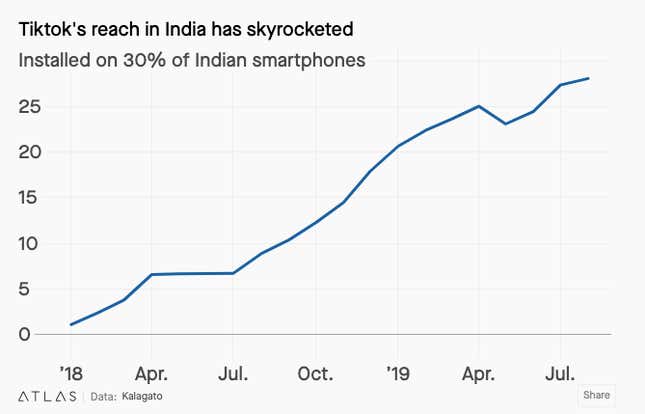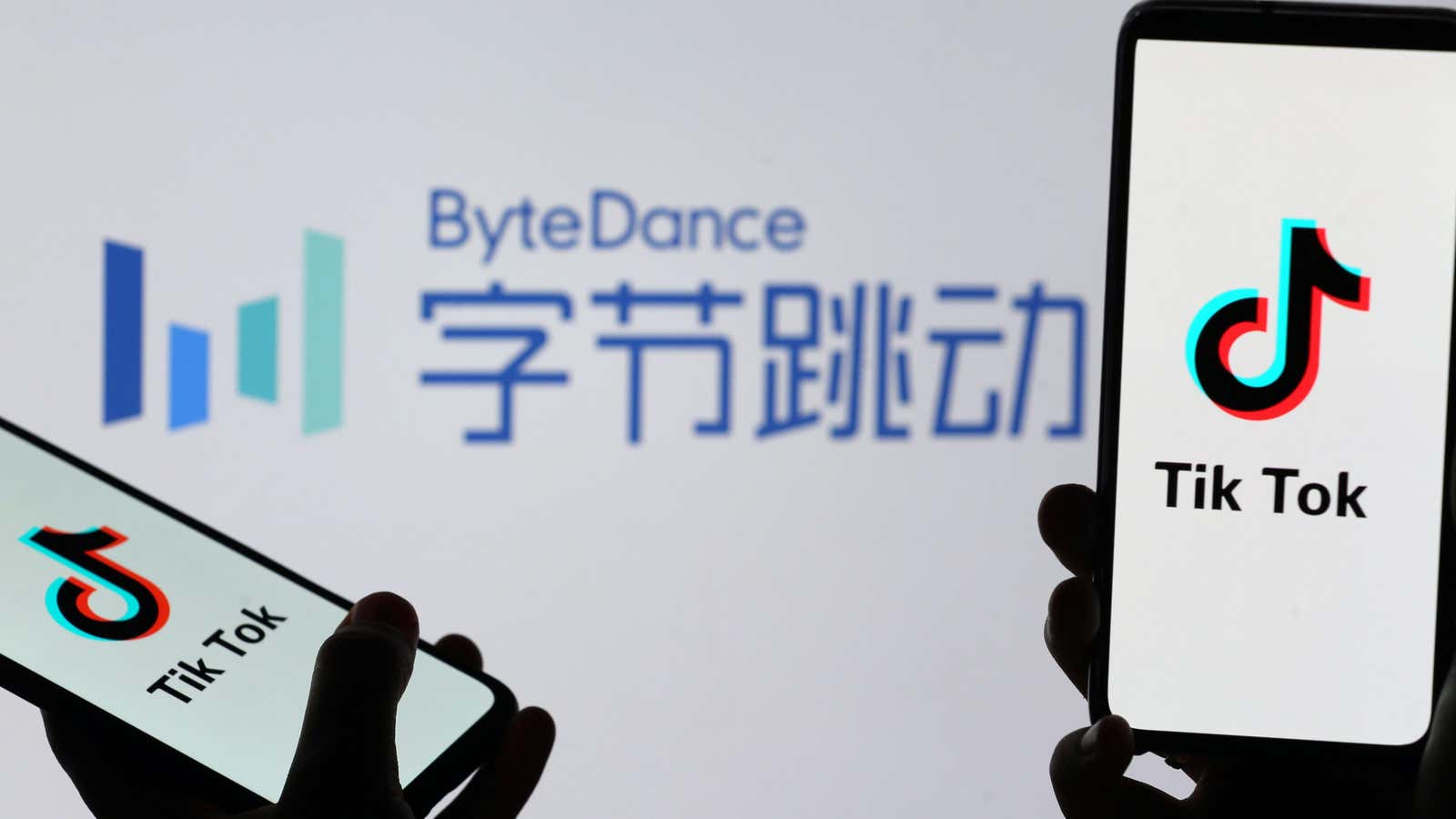India has banned TikTok, and millions of Indians are in a tizzy.
Amid heightened border tension, yesterday (June 29), the Narendra Modi government announced a ban on 59 Chinese apps in an attempt to “safeguard” Indian mobile and internet users. The government said it has received several complaints about these apps “stealing and surreptitiously transmitting users’ data in an unauthorised manner to servers which have locations outside India.”
The list includes social media apps, multiplayer games, beauty apps, web browsers, and other utility apps. But the one name that’s caused the most uproar is TikTok.
The Beijing-based Bytedance-owned video platform has been a rage in the world’s second-largest internet market over the last couple of years. With more than 119 million active users and over 600 million downloads, India is TikTok’s biggest driver.
In 2019, Indians accounted for 48% of the time spent on TikTok by users outside China.
The ban is expected to hit TikTok in a big way, but this is not the first time that the app has landed into hot soup in India. Here’s a timeline of TikTok’s rollercoaster journey in the country:
September 2017: ByteDance launches TikTok globally.
October 2018: A 24-year-old man from Chennai allegedly dies by suicide following harassment by TikTok users for posting videos of himself dressed as a female.
January 2019: S Ramadoss, founder of Tamil Nadu’s Pattali Makkal Katchi political party asks the state government to ban TikTok alleging that it distracts children and leads them to be sexually perverse.
February 2019: Tamil Nadu’s IT minister M Manikandan says the state will seek the centre’s help to seek a ban on TikTok for causing degradation of culture and leading law and order related issues.
A few days later, a college student dies, and two of his friends are severely injured, after their motorcycle rams into a truck while they were shooting a video for TikTok.
April 2019: Advocate and social activist Muthu Kumar files a plea in the Madras high court seeking a ban on TikTok for “pornographic” content. After two days, on April 3, Madras high court demands center ban TikTok and prohibits media to broadcast any content created on the app.
On April 24, the Madras court revokes the ban. Meanwhile, TikTok says that it has removed six million videos for not complying with its community guidelines and has also begun serving users a warning advisory to not post fake news.
Listing out its financial consequences, TikTok says the ban was causing it to incur losses of $500,000 (Rs3.48 crore) per day and jeopardising 250 jobs. Additionally, the ban costs the app an estimated 15 million new users.
May 2019: TikTok reclaims its top spot in India as the most downloaded app on app stores.
July 2019: TikTok’s parent firm ByteDance receives a notice from the Indian government for allegedly misusing the platforms for “anti-national activities.” The apps are warned of a possible ban if they fail to submit appropriate responses to the questions by July 22. To win back the government’s trust, TikTok announces plans to establish local data centres in India.
In the same month, it collaborates with the National Skill Development Corporation (NSDC) to educate TikTok’s over 200 million users, including first-time Internet users in India about the ongoing government-driven skill development programmes and vocational training opportunities in the country.

August 2019: TikTok’s explosion in India since January 2018 expands its reach to 30% of all Indian smartphones, according to data provided by Delhi-based market intelligence firm KalaGato.
October 2019: TikTok becomes the most downloaded app, surpassing Facebook and Instagram. Most of the installs are contributed by India, which accounts for 44% of its total downloads.
January 2020: The company releases its first-ever transparency report. India accounts for 36% of the total user information requests from around the world in the first half of 2019.
February 2020: Golden temple in Amritsar bans shooting TikTok videos at its premises. In Hyderabad, police registers a criminal case against Twitter, WhatsApp, and TikTok on charges of facilitating the spread of hatred and enmity between different groups on grounds of religion, and anti-national content.
May 2020: In the ongoing content creator-led YouTube v/s TikTok battle, YouTuber CarryMinati roasts TikTok star Amir Siddiqui in a video that raked in millions of views before being removed for violating terms. Following this, CarryMinati’s fans start downrating TikTok’s listing on the Play Store, bringing down the app ratings from 4.5 to 1.3.
There are allegations that TikTok videos glorified acid attacks, rape, and misogyny. One controversial clip in this debate is from one of the most popular Indian TikTok creators, Faizal Siddiqui. TikTok suspends Siddiqui’s account.
June 25: A 16year-old TikTok star who gained popularity on the app for her dance videos, dies by suicide.
June 29: TikTok, along with other 58 other apps, is banned by the Indian government. Reacting to the development, the app says it complies with all security requirements under the Indian laws.
